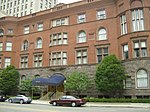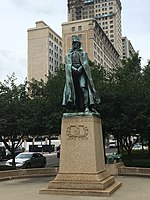Fort/Cass station
1987 establishments in MichiganDetroit building and structure stubsDowntown DetroitMichigan transportation stubsMidwestern United States railway station stubs ... and 1 more
Railway stations in the United States opened in 1987

Fort/Cass station is a Detroit People Mover station in Downtown Detroit, Michigan. It is located at the intersection of Fort Street and Cass Avenue. It serves nearby media sources, including newspaper publishers Detroit Free Press, Detroit News and television station WDIV-TV channel 4. The People Mover shut down temporarily on March 30, 2020, due to decreased ridership amid the COVID-19 pandemic. Following the system's May 2022 restart, the station reopened on September 14, 2022.
Excerpt from the Wikipedia article Fort/Cass station (License: CC BY-SA 3.0, Authors, Images).Fort/Cass station
Cass Avenue, Detroit
Geographical coordinates (GPS) Address Nearby Places Show on map
Geographical coordinates (GPS)
| Latitude | Longitude |
|---|---|
| N 42.32952 ° | E -83.0511 ° |
Address
Fort/Cass
Cass Avenue
48201 Detroit
Michigan, United States
Open on Google Maps











